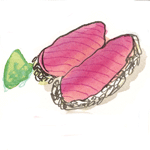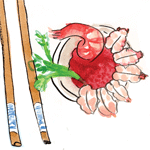5 seafood menu items that are harming the ocean
Emily HunterWebsite
The commercial fishing industry is costing us more than just the price of our seafood platters. With seafood consumption at a record 16.7 kilogram per person, our appetite for fish is putting the entire ocean ecosystem at risk. But the seas aren’t the only thing in danger. We humans depend on those waters for food, income, and even our air. This is how our love of seafood is threatening ourselves as well as our blue planet.
On the menu: B.C. Farmed Salmon
Problem: Fish Farms
Forty percent of our seafood comes from aquaculture. However, it’s hardly the sustainable solution that many believe it is. Farmed fish are fed wild fish, with four to five kilograms of wild stock being used to produce one kilogram of farmed. Coastal farming also infects wild fish with diseases and parasites. In British Columbia, wild pink salmon are on the brink of extinction from aquaculture sea lice. The disappearance of these fish will impact everything from the grizzly bears and orcas that rely on them for food to local communities such as Echo Bay, which rely on them for jobs.
 On the menu: Sharkfin Soup
On the menu: Sharkfin Soup
Problem: Sharkfinning
High demand for shark fin soup in China has led to an explosion in sharkfinning. Thirty-eight million sharks are now being killed annually for their fins, reducing some species by 80 percent over the last 50 years. Losing these top-level predators disrupts the underpinning of the food chain, creating an imbalance that has been linked to the collapse of certain fisheries, such as the Tasmanian rock lobster fishery, where the lack of sharks has resulted in an increase in octopuses, a main predator of the lobsters.
 On the menu: Seaweed
On the menu: Seaweed
Problem:Marine Habitat Loss
The world’s fishing fleets are also negatively impacting such key habitats as coral reefs, wetlands and mangroves. Destroying these environments, and the vegetation within them, sabotages marine reproduction, the ocean’s ability to filter toxins, and, perhaps most importantly, its ability to create oxygen. Seventy percent of the world’s oxygen is produced by a healthy ocean, so we are taking our very breath away with marine habitat loss.
 On the menu: Tuna Sushi
On the menu: Tuna Sushi
Problem: Overfishing
Eighty percent of the world’s fish stocks are fully or over-exploited, including the highly endangered bluefin tuna, a fish prized in the sushi market. If demands are not hampered, the world’s fish stocks will collapse by 2048, causing catastrophic effects on the 170 million people employed in the fishing industry and the 2.9 billion who depend on it for food.
 On the menu: Shrimp in Cocktail Sauce
On the menu: Shrimp in Cocktail Sauce
Problem: By-catch
Each year, millions of non-targeted species, such as sea turtles and dolphins, are accidentally caught as by-catch. This “by-kill” is then either thrown back into the sea or illegally traded, further decimating fish stocks and encouraging the trade of endangered species. While by-catch is a problem for almost every fishery, it’s at its worst with shrimp trawling. Of the 5.3 million tons of shrimp caught annually, 35 percent are discarded, usually because the animals are too small or the wrong sub-species.
Illustrations by Sylvia Nickerson